
Silene is a genus of flowering plants in the family Caryophyllaceae. Containing nearly 900 species, it is the largest genus in the family. Common names include campion and catchfly. Many Silene species are widely distributed, particularly in the northern hemisphere.

Luffa is a genus of tropical and subtropical vines in the pumpkin, squash and gourd family (Cucurbitaceae).

The Egyptian goose is an African member of the duck family Anatidae. Because of their popularity chiefly as an ornamental bird, the species has also been introduced to Europe, United States and elsewhere outside their natural range. Egyptian geese were regularly representated in ancient Egyptian art.

Silene chalcedonica, the Maltese-cross or scarlet lychnis, is a species of flowering plant in the family Caryophyllaceae, native to Eurasia. Other common names include flower of Bristol, Jerusalem cross and nonesuch.

Silene flos-cuculi, commonly called ragged-robin, is a perennial herbaceous plant in the family Caryophyllaceae. It is native to Eurasia and has been introduced to North America.

Silene dioica, known as red campion and red catchfly, is a herbaceous flowering plant in the family Caryophyllaceae, native to Europe and introduced to the Americas.

Silene vulgaris, the bladder campion or maidenstears, is a plant species of the genus Silene of the family Caryophyllaceae. It is native to Europe, temperate Asia, and northern Africa. It has been widely naturalized in North America.
Taverniera is a genus of legume in the family Fabaceae. It includes 17 species of shrubs or shrublets which range from Egypt eastwards to the Arabian Peninsula, Iraq, Iran, Pakistan, and India, and southwards to Ethiopia and Somalia. Typical habitats include seasonally-dry tropical and subtropical desert, shrubland, and bushland.

Orobanche aegyptiaca, the Egyptian broomrape, is a plant which is an obligate holoparasite from the family Orobanchaceae with a complex lifecycle. This parasite is most common in the Middle East and has a wide host range including many economically important crops.
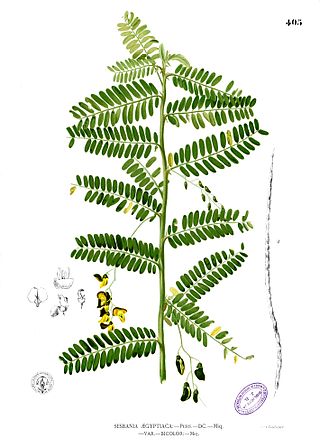
Sesbania sesban, the Egyptian riverhemp, is a species of plant in the legume family, a fast growing species, it has four varieties that are currently recognized.

Balanites aegyptiaca is a species of tree, classified as a member of either the Zygophyllaceae or the Balanitaceae. This tree is native to much of Africa and parts of the Middle East.
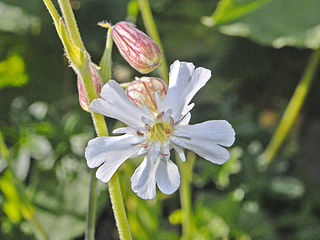
Silene caucasica is a species of flowering plant in the family Caryophyllaceae. It is native to Transcaucasia and Turkey.

The flora of Qatar includes more than 300 species of wild plants. Qatar occupies a small desert peninsula that is around 80 km from east to west and 160 km from north to south. The climate is hot and humid with sporadic rain. Majority of the country is flat with an annual rainfall average of less than 3 inches. Arnebia hispidissim blooms yellow flowers annually in sandy soil. Glossonema edule has edible fruits with brownish-yellow flowers.

Silene otites, called Spanish catchfly, is a species of flowering plant in the genus Silene, native to Europe and the Transcaucasus area, and introduced to Xinjiang in China. It varies its floral odors to attract mosquitoes and moths at night and flies and bees by day. It is dioecious, with separate male and female plants.
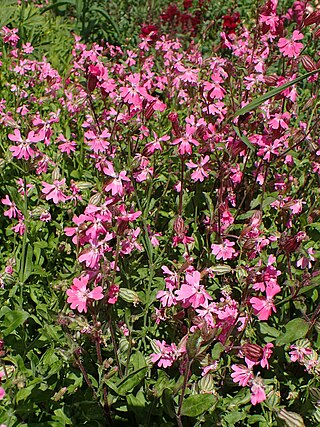
Silene pendula, called the nodding catchfly or drooping catchfly, is a species of flowering plant in the genus Silene, native to Italy, Greece, and Turkey, and introduced to scattered locations in North America, South America, Africa, Europe and Asia. A number of cultivars are available. A 2020 study showed with certainty that, despite their morphological similarities, Silene cisplatensis is not synonymous with Silene pendula.
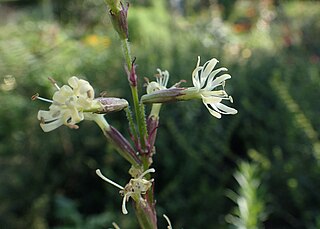
Silene tatarica, called the Tartarian catchfly, is a species of flowering plant in the genus Silene, found in north-central Europe and western Asia, from Germany and Norway eastwards to western Siberia and Kazakhstan. A specialist of riparian habitats, its seeds are dispersed by water.

Silene rubella is a species of flowering plant in the family Caryophyllaceae. In Italy the species goes by the common name silene rosseggiante.
Silene disticha is a species of flowering plant in the family Caryophyllaceae. The species is hermaphroditic and is native to Algeria, Morocco, Portugal, Spain, and Tunisia.
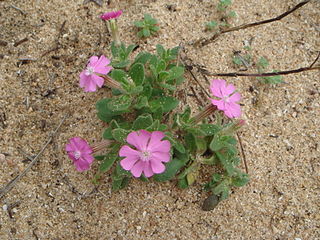
Silene littorea is a species of flowering plant in the family Caryophyllaceae. The species is an annual plant.

Silene italica is a species of plant native to Southern Europe and parts of Asia. It is also introduced to parts of the United States and Northern Europe.



















